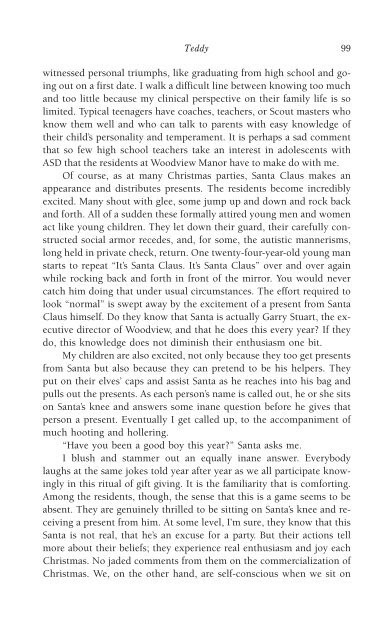978-1572305441
autism
autism
Create successful ePaper yourself
Turn your PDF publications into a flip-book with our unique Google optimized e-Paper software.
Teddy 99<br />
witnessed personal triumphs, like graduating from high school and going<br />
out on a first date. I walk a difficult line between knowing too much<br />
and too little because my clinical perspective on their family life is so<br />
limited. Typical teenagers have coaches, teachers, or Scout masters who<br />
know them well and who can talk to parents with easy knowledge of<br />
their child’s personality and temperament. It is perhaps a sad comment<br />
that so few high school teachers take an interest in adolescents with<br />
ASD that the residents at Woodview Manor have to make do with me.<br />
Of course, as at many Christmas parties, Santa Claus makes an<br />
appearance and distributes presents. The residents become incredibly<br />
excited. Many shout with glee, some jump up and down and rock back<br />
and forth. All of a sudden these formally attired young men and women<br />
act like young children. They let down their guard, their carefully constructed<br />
social armor recedes, and, for some, the autistic mannerisms,<br />
long held in private check, return. One twenty-four-year-old young man<br />
starts to repeat “It’s Santa Claus. It’s Santa Claus” over and over again<br />
while rocking back and forth in front of the mirror. You would never<br />
catch him doing that under usual circumstances. The effort required to<br />
look “normal” is swept away by the excitement of a present from Santa<br />
Claus himself. Do they know that Santa is actually Garry Stuart, the executive<br />
director of Woodview, and that he does this every year? If they<br />
do, this knowledge does not diminish their enthusiasm one bit.<br />
My children are also excited, not only because they too get presents<br />
from Santa but also because they can pretend to be his helpers. They<br />
put on their elves’ caps and assist Santa as he reaches into his bag and<br />
pulls out the presents. As each person’s name is called out, he or she sits<br />
on Santa’s knee and answers some inane question before he gives that<br />
person a present. Eventually I get called up, to the accompaniment of<br />
much hooting and hollering.<br />
“Have you been a good boy this year?” Santa asks me.<br />
I blush and stammer out an equally inane answer. Everybody<br />
laughs at the same jokes told year after year as we all participate knowingly<br />
in this ritual of gift giving. It is the familiarity that is comforting.<br />
Among the residents, though, the sense that this is a game seems to be<br />
absent. They are genuinely thrilled to be sitting on Santa’s knee and receiving<br />
a present from him. At some level, I’m sure, they know that this<br />
Santa is not real, that he’s an excuse for a party. But their actions tell<br />
more about their beliefs; they experience real enthusiasm and joy each<br />
Christmas. No jaded comments from them on the commercialization of<br />
Christmas. We, on the other hand, are self-conscious when we sit on



